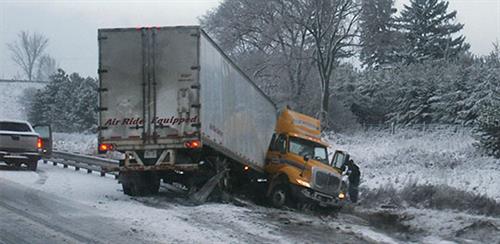 Losing control of any vehicle is scary. When it’s a large truck, it can be deadly. Every day, you negotiate traffic and try to avoid collisions with other vehicles on the road. But collisions do happen and they account for 12% of all injuries and 26% of all injury costs for independent contractors. In order to avoid collisions, you should:
Losing control of any vehicle is scary. When it’s a large truck, it can be deadly. Every day, you negotiate traffic and try to avoid collisions with other vehicles on the road. But collisions do happen and they account for 12% of all injuries and 26% of all injury costs for independent contractors. In order to avoid collisions, you should:
- Conduct a post-collision analysis to identify the actual, remote, early and direct cause factors of the collision.
- Were you following too closely?
- Were you distracted?
- Were you fatigued?
- Were you in a rush because the load was late?
- Did poor road, weather, lighting or equipment conditions impact your ability to drive safely?
If you answered “yes” to any of these questions, you need to examine why each of those conditions existed. This will help you to drill down to the root cause of the loss. Download our post-collision analysis worksheet >>
- Once you have determined the cause, educate yourself and your drivers on preventing future accidents. Protective offers online training that provides interactive safety videos on defensive driving, hours of service, CSA, worker injury prevention and more.
- Examine your route and, if necessary, modify it to reduce driving in areas with high collision exposure. As part of your pre-trip preparation, check the road conditions to determine if there are areas of heavy traffic congestion so you can prepare for the conditions, or choose an alternate route or alternate times to be in the area.
- Talk with your physician about any medical conditions that may have contributed to the accident, such as poor eyesight or fatigue, and discuss possible treatments that will eliminate the condition or reduce its impact on your driving.
Categorized in:
-
Health & Wellness
-
Driving Techniques
-
Driver Management
-
Injury Prevention
-
Transportation Safety
ClickToAddCategories
No categories have been created yet.
Community
Company Updates
Driver Recruitment
Investor News
Transportation Safety
Claims
Driver Management
Driving Techniques
Distracted Driving
Seasonal Driving Tips
Sharing the Road
Health & Wellness
Injury Prevention
Regulations
Security & Cargo Theft
Vehicle Inspections
Weather Conditions
Workplace Safety
Workers Compensation
Done